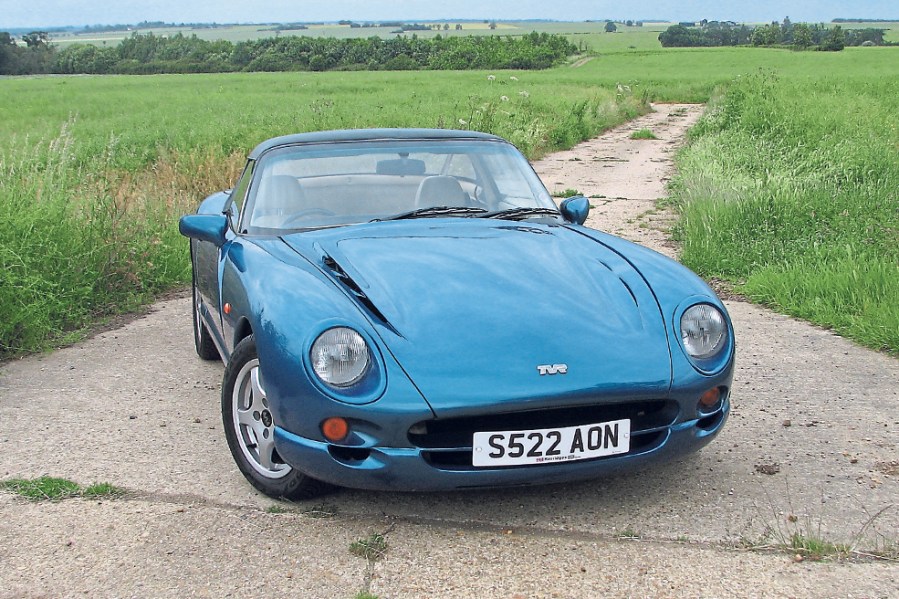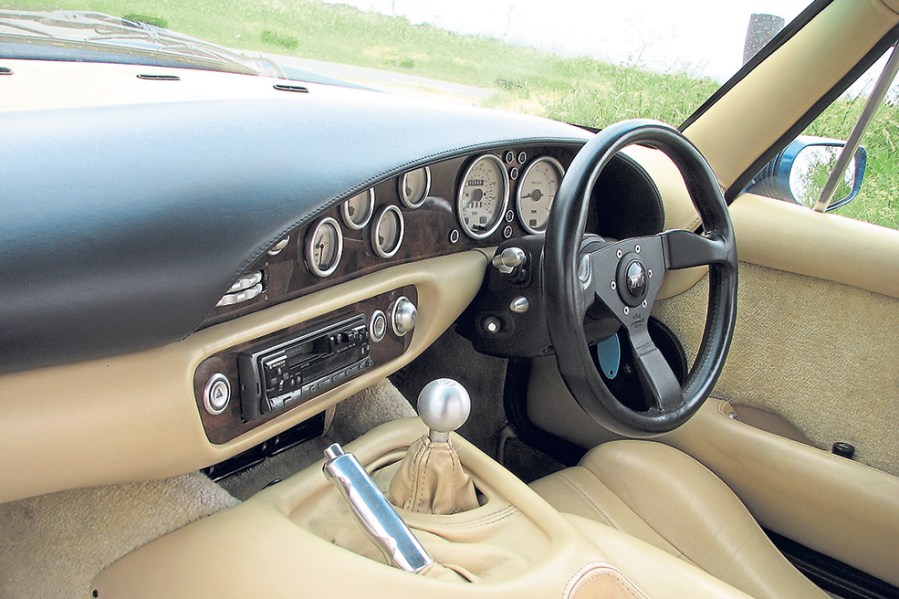If most modern-classic sports cars are too mainstream for your tastes, you might be tempted by the TVR Chimaera. Here’s how to buy a great one today
Words: Paul Guinness
Mention the fact that you’re considering buying a TVR to anyone you happen to bump into at your local boozer and you’ll be greeted with an initial look of excitement followed by a wince and something along the lines of: “But what about the build quality?” It’s true that TVR did go through a bad patch in terms of quality and reliability. Critics might argue that the bad patch actually lasted several decades, but that would be harsh. By the time the Chimaera came along in 1992, build standards were drastically improved. Not only that, the Griffith-derived Chimaera was designed to be the most user-friendly – and most practical – TVR the world had ever seen.
Although the 1992–2003 Chimaera demanded fewer compromises from its owners than any TVR before, it had lost none of its driver appeal in the process. It was still a quick machine in the great TVR tradition, employing ex-Rover V8 power in a choice of capacity and output. During the Chimaera’s career, buyers were offered 4.0-, 4.3-, 4.5- and 5.0-litre versions (linked to Borg Warner’s excellent T5 transmission from 1994), pushing out between 240 and 340bhp – which means that even the least powerful Chimaera is a seriously quick machine.
The Chimaera shared the same backbone chassis as the no-frills Griffith, and offered a similar range of modified engines. Crucially, however, it was longer and more spacious, with slightly softer suspension settings for a less back-breaking ride. It brought the prospect of TVR ownership to a wider than ever range of potential customers, helping the Chimaera to become its maker’s best-selling model of all time – with three sold for every one Griffith. By the time production ceased, over 6000 Chimaeras had left TVR’s Blackpool production line.
TVR didn’t rest on its laurels, with no fewer than three minor facelifts throughout the Chimaera’s career, plus availability in an ever-expanding choice of colour and trim combinations. For what was a specialist, high-performance sportster, the Chimaera even managed to offer decent value; by 1996, for example, it cost £29,450 or £34,595 depending on whether you opted for the 4.0- or 5.0-litre model, the latter being exactly the same price as the hardcore 5.0-litre Griffith. And these days, what was arguably TVR’s finest all-rounder remains relatively affordable – but what should you check before taking the plunge?

Bodywork
The biggest problem went it comes to the chassis is rusting of the outriggers that support the body and seatbelt anchorages. The factory coating can leave moisture seeping in underneath. While cosmetically it may not be obvious, it’s difficult to know exactly how bad the issue is, so consulting with a specialist is sensible. Preventative measures are available, but ask to see receipts of this work having been carried out. It’s possible to do the work by only slightly raising the bodywork from the chassis, but most specialists prefer to lift the entire body off. Not only does this make it easier to attack the problem, it also allows the specialist to properly assess the chassis’ problematic areas. As you can imagine, the labour involved with such a job is expensive, so it’s best to be aware of this prior to buying.
There are two points that coincide quite nicely here; remember, the body is made of glassfibre, so you have no concerns regarding panel rust – but it can damage easily. It’s worth remembering that even in basic form, a 4.0-litre V8 producing 275bhp can propel the Chimaera to 60mph in 4.7 seconds; so much power being transported to the two rear wheels can make it a handful to drive in anything but dry conditions, and many will have encountered unexpected oversteer and possibly ended up in a ditch. Make sure you check for accident damage; if it isn’t straight, don’t buy it.
Just because the bodywork is glassfibre, that’s no excuse not to check over it. Stone chips are the biggest threat here and can really harm the front end if it’s never been attended to. Resprays are common, but you should again check who carried the work out and the cost of doing so. Also check to make sure the respray is the correct paint code. Have a feel of the paintwork – you can normally tell ‘bodged’ jobs, and it also gives you a chance to feel for any covered-up accident damage.
Panel fitment is renowned for being good, but doors can drop a little. Don’t be too worried if the doors hang slightly low as the hinges can be adjusted. If any other panels are noticeably gaping, this might be a sign of a previous accident.
Be sure to check the soft-top, too, as the rear screen is susceptible to damage. Some owners opt to place a towel in the middle of the screen to avoid scratches when folded down.

Engine and transmission
As previously mentioned, the Chimaera comes in various V8 engine formats ranging from 4.0-litre to 5.0-litre. The same principles for checking any engine should be taken here. Before firing it up, remove the oil filler cap and look for any emulsified ‘mayo’, a sure sign of head gasket failure. Check that the engine starts from cold smoothly and idles nicely without excessive ‘hunting’. Oil leaks are common on the Rover V8 units, so don’t be overly concerned about signs of a slight leak around the rocker covers. However, do make sure that the rocker cover screws are correctly tightened down, as this obviously helps to fight oil leaks.
Rover V8s suffer from camshaft problems, something that isn’t specific to the TVR. If the maintenance schedule for fresh oil every 6000 miles has been adhered to, this shouldn’t be a problem. However, you can expect to replace the camshaft every 50,000 miles, with the cam chain being replaced every 100,000 miles. Have a look through the history to see whether it has been done before; if not, factor this into the costs.
Overheating shouldn’t be a primary concern, even less so on post-1995 cars that featured an uprated radiator. The thermostat should kick the cooling fan into life when temperatures reach 90 degrees Celsius; if not, it’s almost certainly the thermostat that’s at fault.
Once you’ve taken the car for a test drive and it’s fully up to temperature, switch the motor off and back on again. It should fire straight back up, but it has been known not to. High temperatures can cause the starter motor to fail, so a quick start-up is an indication that everything is under control.
The GKN differential on the Chimaera is known to whine with age; this isn’t a major issue, but you should look at getting it replaced at some point. Any sort of ‘grumbles’ point to more serious problems. The later models used a Salisbury limited-slip diff that’s known to be tough, but watch for oil leaks.
Original Chimaeras used the ex-Rover LT77 gearbox, while later cars (August 1994 onwards) used Borg Warner T5 units. Both are considered strong and reliable, so you should be happy with either. It’s easy to identify which is which; the LT gearbox has the reverse gear to the left of first gear, while the T5 has it down from fifth.
A typical trait of the T5 box is a crunch into reverse, so don’t worry if this is the case. To avoid it you can select a forward gear and then go into reverse. While the T5 box is generally perceived as being the stronger one, opting to fit this in older models is a tough job as the centre tunnel needs to be widened. The only time this would prove worthwhile is if the chassis was being replaced anyway.

Suspension, steering and brakes
You need to ensure that any Chimaera’s suspension is in good order, with no signs of ‘sagginess’ on your test drive and no untoward bangs or knocks over bumps and potholes. The steel wishbones are relatively straightforward and cheap to replace if there is an issue. You should carry out the usual checks when it comes to springs and dampers; push down on each corner and the body should return to its original state in one motion. Check that the tyres are wearing evenly; if not, it could be a sign of suspension damage or misaligned wheels.
If you hear any clunks from the front end, the bushes are the likely culprit. Some owners opt for upgraded Nitron or Gaz suspension; standard-spec cars should feature a Bilstein set-up, which has proven to be reliable in use. If the suspension is tired and in need of improvement, upgrading the bushes to nylon is a good idea for longevity.
The TVR’s rack and pinion steering is direct and generally trouble-free. Prior to 1999, it was non-assisted; some owners prefer the more direct response of this original set up, but it can be hard work at low speed. It’s not a guarantee that all post-1999 cars have PAS, as for cost-cutting reasons it wasn’t always included. Many buyers specifically look for this hydraulically assisted system; but if the car you’re inspecting does have power-steering, look for leaks around the rack or pump, as costs can spiral quickly.
The Chimaera’s brakes are regular Ford items, which means easy parts availability – as well as cost savings if you shop around. The weakest part of the braking system is the handbrake cable; check this for corrosion as it can snap.
You need to be particularly vigilant when checking any TVR’s electrics, so make sure everything (including the instrument panel backlight) is working, especially as the ECU, battery and relays are all in the front passenger footwell area and therefore prone to damp problems.

TVR Chimaera: our verdict
Chimaera values bottomed out some time ago, and there are indications that the finest examples are now on the rise. Nevertheless, it still offers excellent value by hand-built sports car standards, and is undoubtedly the easiest-to-live-with of all the classic TVRs. Buy a decent, unmolested survivor and you’ll get to enjoy one of Blackpool’s best all-rounders – as well as a car with good ‘investment’ potential if you plan to keep it long-term.
If you want a reliable, hassle-free Chimaera that’s ready to enjoy, don’t go looking for one of the cheapest. While examples can be had for as little as £10,000–12,000, you’ll inevitably end up spending a few more thousand rectifying various faults and carrying out improvements.
If you’re happy with a 4.0-litre version (whether in original or high-compression format), you’ll find plenty of choice for around the £15,000–18,000 mark – a figure that should get you a car with fewer than 50,000 miles under its wheels and an excellent service history. At the other extreme, Chimaera 500s carry a premium over the regular models and can typically be seen for sale at between £25,000 and £30,000.














